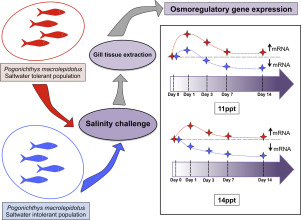当前位置:
X-MOL 学术
›
Comp. Biochem. Physiol. A Mol. Integr. Physiol.
›
论文详情
Our official English website, www.x-mol.net, welcomes your feedback! (Note: you will need to create a separate account there.)
Differential regulation of select osmoregulatory genes and Na+/K+-ATPase paralogs may contribute to population differences in salinity tolerance in a semi-anadromous fish.
Comparative Biochemistry and Physiology A: Molecular & Integrative Physiology ( IF 2.3 ) Pub Date : 2019-10-30 , DOI: 10.1016/j.cbpa.2019.110584 Paige C Mundy 1 , Ken M Jeffries 2 , Nann A Fangue 3 , Richard E Connon 1
Comparative Biochemistry and Physiology A: Molecular & Integrative Physiology ( IF 2.3 ) Pub Date : 2019-10-30 , DOI: 10.1016/j.cbpa.2019.110584 Paige C Mundy 1 , Ken M Jeffries 2 , Nann A Fangue 3 , Richard E Connon 1
Affiliation

|
The Sacramento splittail (Pogonichthys macrolepidotus) is a species of special concern that is native to the San Francisco Estuary, USA. Two genetically distinct populations exist and differ in maximal salinity tolerances. We examined the expression of 12 genes representative of osmoregulatory functions in the gill over a 14 day time course at two different salinities [11 or 14 PSU (Practical Salinity Units)] and revealed that each population showed distinct patterns of gene expression consistent with population differences in response to osmotic regimes. The relatively more salinity-tolerant San Pablo population significantly upregulated nine out of the 12 transcripts investigated on day 1 of 11 PSU salinity exposure in comparison to the day zero freshwater control. Three transcripts (nka1a, nka1b, and mmp13) were differentially expressed between the populations at 7 and 14 days of salinity exposure, suggesting a reduced ability of the relatively salinity-intolerant Central Valley population to recover. Additionally, a phylogenetic analysis of several Sacramento splittail Na+/K+-ATPase α1 sequences resulted in grouping by proposed paralog rather than species, suggesting that different paralogs of this gene may exist. These findings, together with prior research conducted on the Sacramento splittail, suggest that the San Pablo population may be able to preferentially regulate select osmoregulatory genes, including different Na+/K+-ATPase α1 paralogs, to better cope with salinity challenges.
中文翻译:

所选渗透调节基因和Na + / K + -ATPase旁系同源物的差异调节可能会导致半厌食鱼的耐盐性种群差异。
萨克拉曼多裂尾鱼(Pogonichthys macrolepidotus)是一种特别受关注的物种,原产于美国旧金山河口。存在两个遗传上不同的种群,并且最大耐盐性不同。我们在14天的时间过程中,在两种不同的盐度[11或14 PSU(实用盐度单位)]下检查了representative中代表渗透调节功能的12个基因的表达,并揭示了每个种群均显示出与种群差异一致的不同基因表达模式响应渗透机制。与零日淡水对照相比,相对耐盐度较高的圣巴勃罗种群在11个PSU盐度暴露的第1天调查的12个转录本中有9个显着上调。三个成绩单(nka1a,nka1b,盐度暴露的第7天和第14天,这些种群之间的差异表达(表明Mp13和mmp13),这表明相对不耐盐的中部山谷种群恢复能力降低。此外,对几个萨克拉曼多尾尾Na + / K + -ATPaseα1序列进行系统进化分析,结果是按拟议的旁系同源物而不是物种进行分组,表明该基因可能存在不同的旁系同源物。这些发现以及对萨克拉门托裂尾的先前研究表明,圣巴勃罗族可能能够优先调节选择的渗透调节基因,包括不同的Na + / K + -ATPaseα1旁系同源物,以更好地应对盐分挑战。这表明相对不耐盐的中央谷地种群恢复能力降低。此外,对几个萨克拉曼多尾尾Na + / K + -ATPaseα1序列进行系统进化分析,结果是按拟议的旁系同源物而不是物种进行分组,表明该基因可能存在不同的旁系同源物。这些发现以及对萨克拉门托裂尾的先前研究表明,圣巴勃罗族可能能够优先调节选择的渗透调节基因,包括不同的Na + / K + -ATPaseα1旁系同源物,以更好地应对盐分挑战。这表明相对不耐盐的中央谷地种群恢复能力降低。此外,对几个萨克拉曼多尾尾Na + / K + -ATPaseα1序列进行系统进化分析,结果是按拟议的旁系同源物而不是物种进行分组,表明该基因可能存在不同的旁系同源物。这些发现以及对萨克拉门托裂尾的先前研究表明,圣巴勃罗族可能能够优先调节选择的渗透调节基因,包括不同的Na + / K + -ATPaseα1旁系同源物,以更好地应对盐分挑战。
更新日期:2019-10-30
中文翻译:

所选渗透调节基因和Na + / K + -ATPase旁系同源物的差异调节可能会导致半厌食鱼的耐盐性种群差异。
萨克拉曼多裂尾鱼(Pogonichthys macrolepidotus)是一种特别受关注的物种,原产于美国旧金山河口。存在两个遗传上不同的种群,并且最大耐盐性不同。我们在14天的时间过程中,在两种不同的盐度[11或14 PSU(实用盐度单位)]下检查了representative中代表渗透调节功能的12个基因的表达,并揭示了每个种群均显示出与种群差异一致的不同基因表达模式响应渗透机制。与零日淡水对照相比,相对耐盐度较高的圣巴勃罗种群在11个PSU盐度暴露的第1天调查的12个转录本中有9个显着上调。三个成绩单(nka1a,nka1b,盐度暴露的第7天和第14天,这些种群之间的差异表达(表明Mp13和mmp13),这表明相对不耐盐的中部山谷种群恢复能力降低。此外,对几个萨克拉曼多尾尾Na + / K + -ATPaseα1序列进行系统进化分析,结果是按拟议的旁系同源物而不是物种进行分组,表明该基因可能存在不同的旁系同源物。这些发现以及对萨克拉门托裂尾的先前研究表明,圣巴勃罗族可能能够优先调节选择的渗透调节基因,包括不同的Na + / K + -ATPaseα1旁系同源物,以更好地应对盐分挑战。这表明相对不耐盐的中央谷地种群恢复能力降低。此外,对几个萨克拉曼多尾尾Na + / K + -ATPaseα1序列进行系统进化分析,结果是按拟议的旁系同源物而不是物种进行分组,表明该基因可能存在不同的旁系同源物。这些发现以及对萨克拉门托裂尾的先前研究表明,圣巴勃罗族可能能够优先调节选择的渗透调节基因,包括不同的Na + / K + -ATPaseα1旁系同源物,以更好地应对盐分挑战。这表明相对不耐盐的中央谷地种群恢复能力降低。此外,对几个萨克拉曼多尾尾Na + / K + -ATPaseα1序列进行系统进化分析,结果是按拟议的旁系同源物而不是物种进行分组,表明该基因可能存在不同的旁系同源物。这些发现以及对萨克拉门托裂尾的先前研究表明,圣巴勃罗族可能能够优先调节选择的渗透调节基因,包括不同的Na + / K + -ATPaseα1旁系同源物,以更好地应对盐分挑战。



























 京公网安备 11010802027423号
京公网安备 11010802027423号